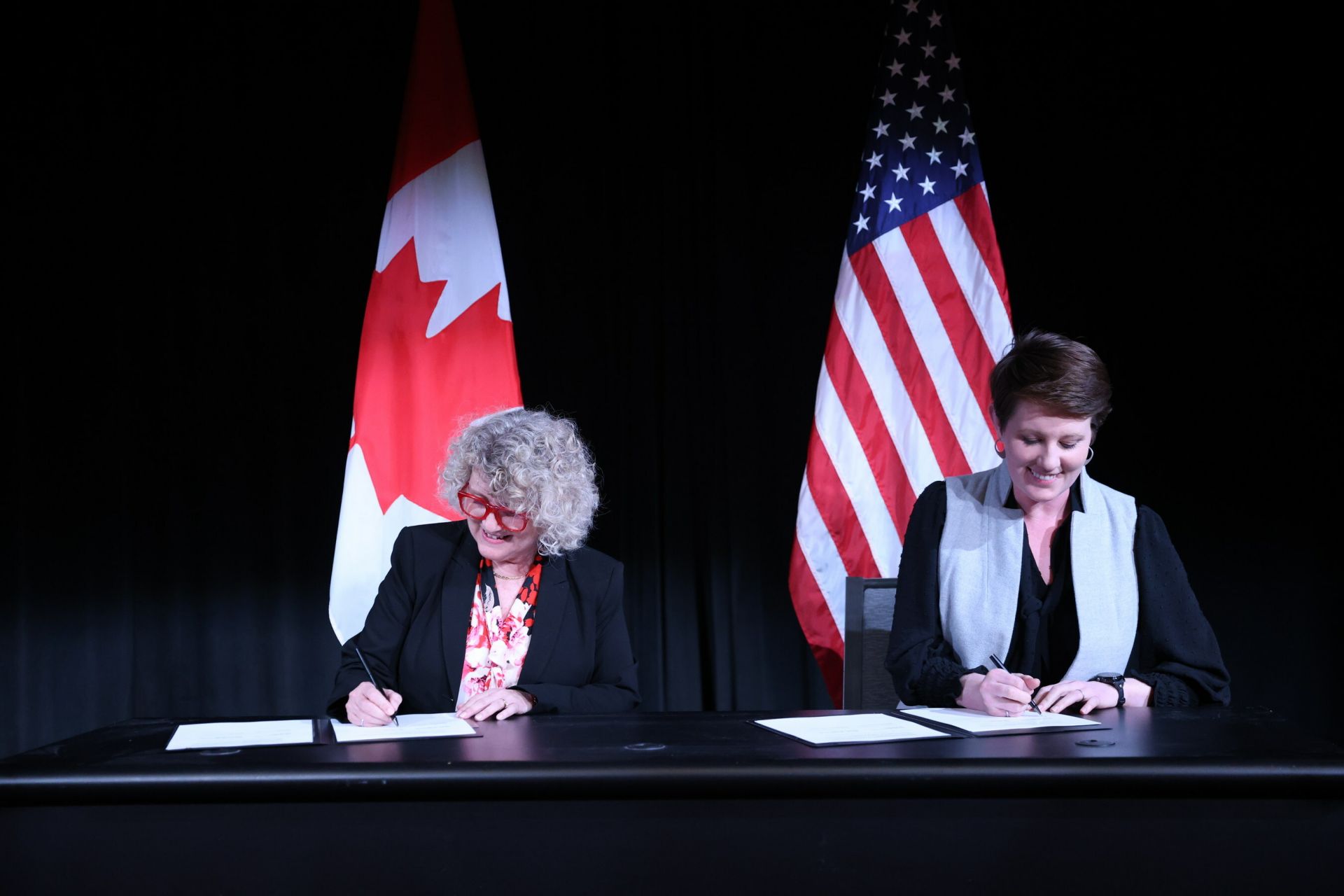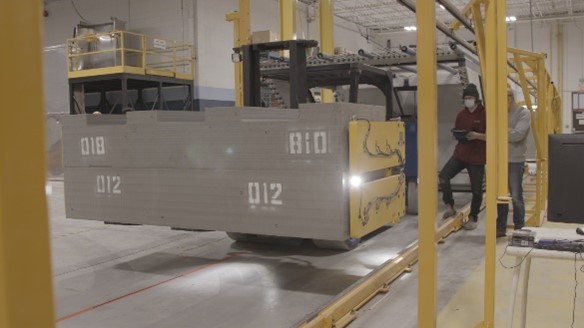The NWMO’s Laurie Swami (left) and the DOE’s Kathryn Huff sign a statement of intent to cooperate on used nuclear fuel management in Washington, D.C., on May 16. (Photo: CNW Group/NWMO)
The United States and Canada will cooperate on spent nuclear fuel management under a statement of intent (SOI) signed between the U.S. Department of Energy and the Nuclear Waste Management Organization, the nonprofit responsible for the management of Canada’s commercial spent fuel.
The ministers representing their respective nations as the statement on civil nuclear fuel cooperation was announced were (from left) Jonathan Wilkinson, minister of natural resources of Canada; Yasutoshi Nishimura, Japan’s minister of economy, trade, and industry; Jennifer Granholm, U.S. energy secretary; Grant Shapps, U.K. energy security secretary; and Agnes Pannier-Runacher, French minister for energy transition.
A civil nuclear fuel security agreement between the five nuclear leaders of the G7—announced on April 16 on the sidelines of the G7 Ministers’ Meeting on Climate, Energy and Environment in Sapporo, Japan—establishes cooperation between Canada, France, Japan, the United Kingdom, and the United States to flatten Russia’s influence in the global nuclear fuel supply chain.
A technical collaboration agreement was signed by (seated from left) Jay Wileman, GEH; Jeff Lyash, TVA; Ken Hartwick, OPG; and Rafał Kasprów, SGE; and was observed by dignitaries and an audience both in-person and online. (Photo: TVA)
“I’m glad you came to our party!” said GE Hitachi Nuclear Energy (GEH) chief nuclear officer Nicole Holmes as she prepared to announce that Wilmington, N.C.–based GEH will develop a standard design for its BWRX-300 boiling water small modular reactor with not one but three power producers representing three countries: Tennessee Valley Authority (TVA), Ontario Power Generation (OPG), and Synthos Green Energy (SGE). Celebration was a theme throughout the March 23 event held in Washington, D.C., which was flush with dignitaries representing the United States, Canada, and Poland.
Canadian Nuclear Laboratories (Photo: AECL)
Atomic Energy of Canada Limited (AECL) has published a request for expressions of interest to manage and operate Canadian Nuclear Laboratories (CNL). The request is available on the MERX website.
According to AECL, the objective of the procurement and the resulting contract is to contain or reduce costs and risks for Canadian taxpayers while leveraging CNL’s capabilities and resources for Canadians.
Expressions of interest must be submitted via MERX on or before October 26, 2022.
Ontario’s South Bruce area is being considered as a potential host site for a spent fuel repository. (Photo: NWMO)
Canada’s Nuclear Waste Management Organization (NWMO) is shifting the timing for selecting a preferred site for a spent nuclear fuel repository to the fall of 2024, a full year later than previously planned. The NWMO, a nonprofit organization tasked with the safe, long-term management of Canada’s spent fuel in a deep geological repository, said the delay is the result of several provincial lockdowns associated with the COVID-19 pandemic.
Myrna Simpson conducts molecular biogeochemistry research at the University of Toronto Scarborough. (Photo: Ken Jones/University of Toronto)
Researchers at three Canadian universities are studying whether bentonite clay—used as an engineered barrier in Canada’s proposed deep geological repository—can support sulfide-producing microbes that can eat away at the canisters containing spent nuclear fuel.
A modified forklift with a customized handling attachment is used to move spent fuel containers and their heavy bentonite clay housings. It can move autonomously or be manually operated remotely from outside the room, as needed. (Photo: NWMO)
Canada’s Nuclear Waste Management Organization (NWMO) has announced that it has successfully completed a full-scale demonstration of the engineered barriers that are designed to contain and isolate Canada’s spent nuclear fuel in a deep geological repository.
Artist’s rendering of a BWRX-300 plant. (Image: GE Hitachi Nuclear Energy)
Ontario-based GEH SMR Technologies Canada Ltd. and the Saskatchewan Industrial and Mining Suppliers Association (SIMSA) announced yesterday the signing of a memorandum of understanding focused on the potential deployment of the BWRX-300 small modular reactor in Saskatchewan.
The MOU calls for engaging with local suppliers to maximize the role of the Saskatchewan supply chain in the nuclear energy industry.
McMaster University, in Hamilton, Ontario, Canada. (Photo: McMaster University)
McMaster University, Ultra Safe Nuclear Corporation (USNC), and Global First Power (GFP) have embarked on a new partnership to study the feasibility of deploying a USNC Micro Modular Reactor (MMR) at McMaster University or an affiliated site. The three partners last week announced a memorandum of understanding that will support research on advanced reactor and small modular reactor technologies in support of Canada’s Net-Zero Emissions by 2050 goal.

Representatives from Westinghouse and Penn State met at Westinghouse headquarters to sign a memorandum of understanding and enter a partnership focused on researching and developing microreactors. From left: Jason Beebe, director of the global transformation office at Westinghouse; Michael Valore, senior director of advance reactor commercialization, Westinghouse; Mike Shaqqo, senior vice president of advanced reactors, Westinghouse; Lora Weiss, senior vice president for research at Penn State; Jean Paul Allain, head of the Ken and Mary Alice Lindquist Department of Nuclear Engineering at Penn State; Geanie Umberger, associate vice president for research and director of industry research collaborations at Penn State; Saya Lee, assistant professor of nuclear engineering; Elia Merzari (back), associate professor of nuclear engineering; and Hilary Ruby, director of transformation for the Americas Operating Plant Services Business Unit at Westinghouse. (Photo: Westinghouse)
An NWMO geoscientist examines core samples pulled from rock in South Bruce, Ontario, as part of investigations of a potential deep geological repository. (Photo: NWMO)
Canada’s Nuclear Waste Management Organization (NWMO) has completed a deep borehole drilling program at the two sites in Ontario under investigation for potentially hosting a deep geological repository to hold the country’s spent nuclear fuel. The NWMO said that Canada’s top geoscientists are leading the studies, in which approximately eight kilometers of core samples were pulled from the bedrock in the Wabigoon-Ignace area and the Saugeen Ojibway Nation (SON)–South Bruce area.
Ontario clean energy leaders. From left: John Gorman, president and chief executive officer of the Canadian Nuclear Association; Ken Hartwick, president and CEO of Ontario Power Generation; Todd Smith, Ontario’s minister of energy; and Mike Rencheck, Bruce Power president and CEO. (Photo: Bruce Power)
Bruce Power and Ontario Power Generation (OPG) have announced an agreement to work together to support new nuclear technologies in Ontario. Bruce Power operates the Bruce nuclear plant and OPG operates the Darlington and Pickering facilities.
François-Philippe Champagne, Canada’s minister of innovation, Science, and Industry (center, foreground), visited Westinghouse Electric Canada’s Burlington, Ontario, facility for the March 17 announcement. (Photo: Westinghouse)
The Canadian government has announced an investment of C$27.2 million (about $21.6 million) in Westinghouse Electric Canada to support the development of the company’s eVinci microreactor technology.
François-Philippe Champagne, Canada’s minister of Innovation, Science, and Industry, made the announcement on March 17 during a visit to the company’s Burlington, Ontario, facility.


 Atomic Energy of Canada Limited (AECL), Canadian Nuclear Laboratories (CNL), and the Algonquins of Pikwakanagan First Nation (AOPFN) have signed a long-term relationship agreement that aims to foster mutual respect, collaboration, and economic opportunities between Canada’s indigenous communities and the nuclear industry.
Atomic Energy of Canada Limited (AECL), Canadian Nuclear Laboratories (CNL), and the Algonquins of Pikwakanagan First Nation (AOPFN) have signed a long-term relationship agreement that aims to foster mutual respect, collaboration, and economic opportunities between Canada’s indigenous communities and the nuclear industry.












.jpg)
